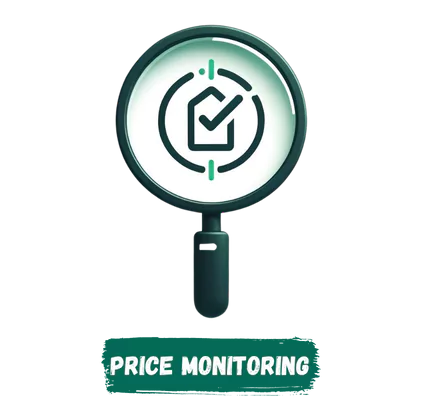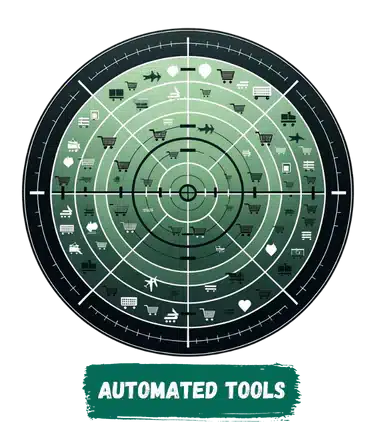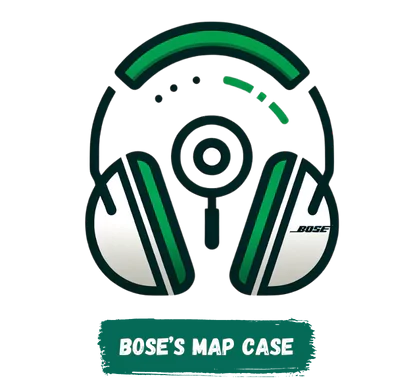Tired of unauthorized sellers undercutting your prices and damaging your brand reputation? Frustrated by a lack of control over how your products are presented online? Effective MAP monitoring is the solution. As a brand, you invest in quality, reputation, and building a strong reseller network. Minimum advertised price (MAP) monitoring gives you the tools to protect that investment and ensure a healthy marketplace for everyone. In this guide, we’ll show you how.
Table of Contents
- What Is MAP (Minimum Advertised Price)?
- So What Is Map Monitoring?
- A Real World Example For You To Understand MAP Monitoring
- Why MAP Violations Happen?
- How Do Minimum Advertised Price Monitoring Work?
- Manual MAP Monitoring vs. Automated Software: Which is Right for You?
- When to Consider Automated MAP Monitoring?
- The Role Of Proxies In MAP Monitoring
- Top MAP Monitoring Software Solutions
- Strategies for Better MAP Contracts & Compliance
- What is Resale Price Maintenance (RPM) And How Does It Relate To MAP Monitoring?
- MAP Monitoring Glossary
What Is MAP (Minimum Advertised Price)?
Minimum Advertised Price (MAP) is a policy set by brands to control the lowest price that resellers can advertise their products. It’s designed to protect brand reputation, prevent harmful price wars, and ensure a level playing field for authorized sellers.
Think of it as the price floor – resellers can still sell for more than the MAP, but they can’t publicly advertise your product for a lower price.
MAP policies keep your products from being presented as cheap commodities and help you maintain control of your brand image.
So What Is Map Monitoring?
MAP monitoring is the systematic tracking of brand product pricing across all online channels where they’re sold. It’s your way of catching resellers who violate your MAP policy, intentionally or accidentally.
Essentially, MAP monitoring is about data and enforcement. It empowers:
- Catching resellers who violate MAP policies (and potentially undercut your own prices)
- Identifying unauthorized sellers who might be damaging brand reputation and your supplier relationships.
- Gathering evidence for legal action related to MAP compliance.
- Helping authorized sellers avoid being forced to lower their prices due to the prices unauthorized sellers set (price erosion).

A Real World Example For You To Understand MAP Monitoring
Bose, a renowned audio equipment company, faced challenges with unauthorized sellers on Amazon, undermining their MAP policy. Bose implemented a comprehensive MAP monitoring and enforcement strategy to address these issues.
Bose tackled that challenge by implementing a robust MAP monitoring strategy, partnering with the marketplace to identify and take action against those who advertised their products below the minimum advertised price.
They utilized advanced monitoring tools to swiftly detect violations and engaged in legal actions to deter non-compliant sellers. This comprehensive approach helped them maintain price stability and protect the brand’s reputation.
Bose’s case serves as a compelling example for brands facing similar challenges, highlighting a proactive stance on MAP enforcement can safeguard brand value and ensure market fairness.
Why MAP Violations Happen?
- Too Many Resellers: When your products are sold everywhere, it gets harder to track everyone’s prices. More potential for mistakes or intentional violations.
- Unauthorized Sellers: Sellers who don’t have an agreement with you are more likely to break the rules. They might not even know about your MAP policy.
- Big Stores with Lots of Products: Retailers carrying a ton of your items are usually better about following MAP. They have a stronger relationship with your brand.
How Do Minimum Advertised Price Monitoring Work?
MAP monitoring involves a systematized approach to tracking your product pricing online. Here’s how it breaks down:
- Choosing Your Targets: Identify the key websites, marketplaces, and retailers where your products are sold (Example: Amazon). This includes your authorized resellers and potential hotspots for unauthorized sellers.
- The Power of Automation: While you can manually check prices, MAP monitoring software is essential for efficiency and accuracy. These tools crawl your target sites regularly, flagging any prices below your MAP.
- Data is Key: Monitoring tools collect crucial information, including:
- The advertised price
- The specific seller
- Date and time of the violation
- Screenshots for evidence
- Taking Action: Once you have data, it’s time for communication. Your MAP policy should outline how you handle violations, whether it’s a warning for a first-time offense or stricter consequences for repeat offenders.
Choosing the right MAP monitoring tools is crucial for success. In the next section, we’ll discuss the difference between manual monitoring and automated solutions.
Manual MAP Monitoring vs. Automated Software: Which is Right for You?
Manual Monitoring involves you or your team periodically checking websites and comparing prices to your MAP policy.
- Pros: Low cost, good for very small-scale monitoring
- Cons: Time-consuming, easy to miss violations, difficult to gather robust evidence
On the other hand, Automated MAP Monitoring Software are specialized software platforms that do the heavy lifting for you. They regularly scan your target sites, detect violations, collect data, and often generate reports.
- Pros: Saves time, catches more violations, provides detailed documentation, scales with your business.
- Cons: Requires an investment, may have a learning curve.

When to Consider Automated MAP Monitoring?
If any of the following apply, automated MAP monitoring is likely the better choice:
- You have a sizable product catalog: Tracking numerous products manually is nearly impossible.
- You sell across multiple channels: Monitoring different websites and marketplaces becomes overwhelming quickly.
- You’re serious about MAP enforcement: Automated tools give you the data to confidently address violations.
- You want to proactively identify unauthorized sellers: Software can uncover sellers you may not be aware of.

The Role Of Proxies In MAP Monitoring
Proxies are an essential tool for effective MAP monitoring, especially when using automated solutions. Here’s why they matter:
- Seeing Prices Like Your Customers Do: Prices of your products can vary based on location. Proxies let you “change” your IP address so you can monitor sites as if you were in a specific country, region, or even city. This is crucial to ensure your MAP is being followed everywhere.
- Overcoming Website Blocking: Websites and marketplaces sometimes try to block price monitoring tools. Proxies mask your activity, making it harder for sites to detect and block your monitoring efforts.
- Protecting Your Own Data: When you’re scraping a lot of competitor data, proxies can help prevent your own IP address from being flagged or restricted.
Key Types of Proxies for MAP Monitoring
- Residential Proxies: These are associated with real home internet connections, making them the most difficult for websites to detect.
- Datacenter Proxies: Less expensive than residential proxies, they still offer location flexibility but carry a slightly higher risk of detection.
Top MAP Monitoring Software Solutions
For businesses seeking the best MAP (Minimum Advertised Price) monitoring software in the market, the choices vary widely in features, capabilities, and pricing. The top choices include:
- Trade Vitality: Offers comprehensive MAP monitoring with an easy-to-use interface and robust reporting tools. It’s well-regarded for its effective enforcement workflow.
- MAPP Trap: Known for its detailed analytics and customizable alert system, MAPP Trap provides extensive marketplace coverage and actionable insights.
- PriceSpider: PriceSpider excels in monitoring and enforcement across a vast network of retailers, offering detailed price tracking and brand protection services.
- Wiser: Offers dynamic pricing solutions along with MAP monitoring, providing real-time insights and automated compliance management.
- ORIS Intelligence (now part of PriceSpider): Delivers powerful MAP monitoring and enforcement tools, ensuring brand protection and compliance across multiple online channels.
- ChannelAdvisor: While broader in scope, ChannelAdvisor includes MAP monitoring capabilities, making it a versatile choice for managing online sales channels and compliance.
- TrackStreet: Focuses on AI-driven MAP enforcement and brand protection, offering deep analytics, automated legal enforcement actions, and customizable reporting.
How To Choose?
When selecting MAP monitoring software, prioritize real-time tracking for swift violation detection, comprehensive marketplace coverage for broad monitoring, automated alerts for quick responses, and detailed reporting for in-depth compliance analysis.
Ensure the solution integrates well with your existing systems, offers customization for targeted enforcement, and features a user-friendly interface for ease of use.
Scalability to match your growing business and robust support and training are also critical for maximizing the software’s effectiveness and ensuring seamless operations.

Strategies for Better MAP Contracts & Compliance
Designing effective MAP contracts requires a balance between deterrence (through retroactive and severe penalties) and positive incentives for seller compliance. Here are some tips that can help:
1. Make Penalties Count
- Go Retroactive: Include penalties that apply to past violations, not just future ones. This could involve a financial penalty based on the difference between the MAP and the advertised price or the temporary suspension of the reseller’s ability to sell the product.
- Don’t Hold Back: The penalty needs to be significant enough to truly deter violations. Consider a tiered system where repeat violations result in harsher consequences, such as loss of special discounts or even termination of the reseller agreement.
2. Keep Penalties Focused
One Product, One Violation: Avoid penalties that impact a seller’s access to other products you offer. Keep enforcement at the individual product level.
3. Be Crystal Clear
A. State the Terms: Your MAP contract should include:
- A clear definition of MAP and what it encompasses.
- The exact MAP prices for each covered product.
- A timeline for updating MAP prices, and how you’ll notify resellers of changes.
- A step-by-step outline of the consequences for violations (warnings, fines, etc.).
B. Track Everything: Implement robust monitoring to catch MAP violations quickly across all channels. Consider using MAP monitoring software and outline the frequency of your monitoring in the contract.
4. Reward Good Behavior
Incentivize Compliance: Offer perks like better pricing, marketing support, or exclusive products to resellers who consistently follow your MAP. Here are a few ideas:
- Co-op marketing funds for resellers who consistently follow MAP.
- Priority access to new product launches or limited edition items.
- Volume-based discounts or rebates linked to MAP compliance.
5. Communication is Key
Educate Your Resellers: Explain why MAP benefits everyone involved. Emphasize that it protects their margins, prevents price wars, and maintains the brand’s value proposition. Host webinars or provide online resources to ensure everyone understands your policies.
6. Stay Legal
Consult an Attorney: Always ensure your MAP policy aligns with antitrust and competition laws in the regions where you operate. This is especially important for the structure of penalties and any incentives offered.
What is Resale Price Maintenance (RPM) And How Does It Relate To MAP Monitoring?
Resale Price Maintenance (RPM) is a practice where a brand sets a fixed or minimum price at which retailers must sell their products. It’s a stricter approach than MAP, which only focuses on advertised prices.
RPM Connection to MAP Monitoring
- Understanding the Difference: MAP monitoring tools can sometimes flag potential RPM situations, even if your focus is on advertised prices. It’s important to know the legal distinction between MAP and RPM.
- Legal Considerations: RPM is treated differently under competition law in many countries. While MAP policies are generally permissible, RPM agreements can lead to legal trouble.
The Legalities of MAP vs. RPM
- MAP: Generally Safer Ground In most jurisdictions, MAP policies are considered legal as long as they are structured as unilateral agreements. This means you set the policy, but resellers are not forced to agree before they can sell your products.
- RPM: Treading on Thin Ice RPM often violates antitrust and competition laws. Because it involves setting a fixed resale price, it can be seen as restricting competition and harming consumers.
MAP Monitoring Glossary
1. Minimum Advertised Price (MAP): A vertical pricing policy used by manufacturers to influence downstream prices of channel partners, such as retailers and distributors. This policy sets a minimum price at which products can be advertised, and often includes rewards and punishments for compliance with the policy.
2. Vertical Price Policies: Refers to the range of pricing strategies that manufacturers use to influence downstream prices of channel partners, including MAP. This can encompass setting minimum, maximum, or target prices for products and establishing rewards and punishments for compliance with the policy.
3. Resale Price Maintenance (RPM): A vertical price restraint that manufacturers may use to dictate the price at which retailers can sell their products to customers.
4. Distribution Intensity: Refers to the level or extent of distribution of products through retailers and other channel partners, which influences MAP violations. Products available through a wide range of retail channels tend to experience more MAP violations. This increased exposure makes it challenging to monitor and enforce MAP policies consistently across all retailers.
5. MAP Incentives: Rewards and punishments used by manufacturers to influence retailer behavior in relation to MAP compliance.
6. Price Obfuscation: refers to practices that obscure the actual price of a product from consumers. This can occur in various ways, such as including hidden fees that are only revealed at the end of the purchasing process or using complex discount systems that make it difficult for consumers to understand the final price they will pay. This tactic can undermine MAP policy transparency, create compliance challenges for manufacturers, lead to competitive disadvantages for adherent retailers, erode consumer trust, and distort market dynamics.
Related articles:
- Tags:
- web scraping




